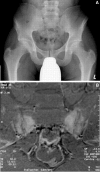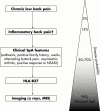Ankylosing spondylitis: an overview
- PMID: 12381506
- PMCID: PMC1766729
- DOI: 10.1136/ard.61.suppl_3.iii8
Ankylosing spondylitis: an overview
Abstract
Ankylosing spondylitis (AS) is a complex, potentially debilitating disease that is insidious in onset, progressing to radiological sacroiliitis over several years. Patients with symptomatic AS lose productivity owing to work disability and unemployment, have a substantial use of healthcare resources, and reduced quality of life. The pathogenesis of AS is poorly understood. However, immune mediated mechanisms involving human leucocyte antigen (HLA)-B27, inflammatory cellular infiltrates, cytokines (for example, tumour necrosis factor alpha and interleukin 10), and genetic and environmental factors are thought to have key roles. The detection of sacroiliitis by radiography, magnetic resonance imaging, or computed tomography in the presence of clinical manifestations is diagnostic for AS, although the presence of inflammatory back pain plus at least two other typical features of spondyloarthropathy (for example, enthesitis and uveitis) is highly predictive of early AS. Non-steroidal anti-inflammatory drugs (NSAIDs) effectively relieve inflammatory symptoms and are presently first line drug treatment. However, NSAID treatment has only a symptomatic effect and probably does not alter the disease course. For symptoms refractory to NSAIDs, second line treatments, including corticosteroids and various disease modifying antirheumatic drugs, are employed but are of limited benefit. Emerging biological therapies target the inflammatory processes underlying AS, and thus, may favourably alter the disease process, in addition to providing symptom relief.
Figures






References
Publication types
MeSH terms
Substances
LinkOut - more resources
Full Text Sources
Medical
Research Materials

